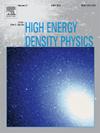Observational and stability analysis of viscosity-driven cosmic acceleration in f(Q,C) gravity
IF 0.9
3区 物理与天体物理
Q3 PHYSICS, FLUIDS & PLASMAS
引用次数: 0
Abstract
This research explores the potential impact of viscosity by using the gravity. We consider two functional forms: and , along with a viscous pressure parameterized by . Using observational datasets (CC 46, BAO 15 and Pantheon 1048) and MCMC techniques, we constrain model parameters and analyze key cosmological quantities. Our investigation reveals a transition from a decelerating to an accelerating phase, characterized by values of and that are compatible with the observational constraints. The equation of state parameter approaches , signaling a late-time acceleration, while the energy conditions indicate a persistent violation of the SEC alongside the stability of NEC, WEC and DEC. Statefinder diagnostics reveal a transition toward CDM-like behavior and the sound speed squared remains positive which ensure model stability throughout cosmic evolution. Our models provide a viable alternative to standard cosmological frameworks, with potential implications for understanding the influence of viscosity in the Universe’s late-time dynamics.
f(Q,C)重力下粘性驱动宇宙加速度的观测与稳定性分析
本研究通过使用f(Q,C)重力来探讨粘度的潜在影响。我们考虑两种函数形式:f(Q,C)=α qδ +βC和f(Q,C)=α−Q+βC+γQ,以及参数化为pv=p−3ζ0ρH的粘性压力。利用cc46、BAO 15和Pantheon 1048等观测数据集和MCMC技术,对模型参数进行了约束,并分析了关键的宇宙学量。我们的研究揭示了从减速到加速阶段的转变,其特征是q0和ztr的值与观测约束相一致。状态参数ω的方程接近- 1,表明后期加速,而能量条件表明持续违反SEC以及NEC, WEC和dec的稳定性。statfinder诊断显示向ΛCDM-like行为过渡,声速平方保持正,确保模型在整个宇宙演化过程中的稳定性。我们的模型为标准宇宙学框架提供了一个可行的替代方案,对理解粘性对宇宙后期动力学的影响具有潜在的意义。
本文章由计算机程序翻译,如有差异,请以英文原文为准。
求助全文
约1分钟内获得全文
求助全文
来源期刊

High Energy Density Physics
PHYSICS, FLUIDS & PLASMAS-
CiteScore
4.20
自引率
6.20%
发文量
13
审稿时长
6-12 weeks
期刊介绍:
High Energy Density Physics is an international journal covering original experimental and related theoretical work studying the physics of matter and radiation under extreme conditions. ''High energy density'' is understood to be an energy density exceeding about 1011 J/m3. The editors and the publisher are committed to provide this fast-growing community with a dedicated high quality channel to distribute their original findings.
Papers suitable for publication in this journal cover topics in both the warm and hot dense matter regimes, such as laboratory studies relevant to non-LTE kinetics at extreme conditions, planetary interiors, astrophysical phenomena, inertial fusion and includes studies of, for example, material properties and both stable and unstable hydrodynamics. Developments in associated theoretical areas, for example the modelling of strongly coupled, partially degenerate and relativistic plasmas, are also covered.
 求助内容:
求助内容: 应助结果提醒方式:
应助结果提醒方式:


